Bromine in Hot Tub Too High? Quick Fixes That Actually Work
Got high bromine levels in your hot tub? First, test the water with strips to confirm. Dilute by draining some water and refilling with fresh.
Add a bromine neutralizer if needed, following product instructions. Retest after 15-30 minutes. Regular maintenance prevents spikes, keeping your hot tub safe and enjoyable for soaking.
Too much bromine in your hot tub can lead to skin irritation, harsh smells, and even damage to parts over time. It’s a common issue, often spotted after testing the water or feeling discomfort during a soak.
Luckily, you don’t need to drain your spa or hire help. With a few simple steps, you can lower the levels safely and prevent it from happening again.
Here’s what we’ll cover:
- Easy prevention tips
- Why bromine gets too high
- Quick fixes that work
- Lowering High Bromine Levels in Hot Tubs
- Understanding Bromine in Hot Tubs
- What Is a Safe Bromine Level in a Hot Tub?
- ✨ Bromine Hot Tub Care Guide
- 🌡️ Bromine Hot Tub Maintenance
- Troubleshooting Bromine Issues
- What Causes High Bromine in a Hot Tub?
- Effects of Low Bromine in a Hot Tub
- Maintaining Balanced Bromine Levels
- What Level of Bromine Is Considered Dangerous?
- Featured Products and Resources
- 🔧 Hot Tub Maintenance Guide
- FAQs
Lowering High Bromine Levels in Hot Tubs
Following these steps will allow you to safely restore your hot tub’s chemistry and maintain a comfortable soaking environment.
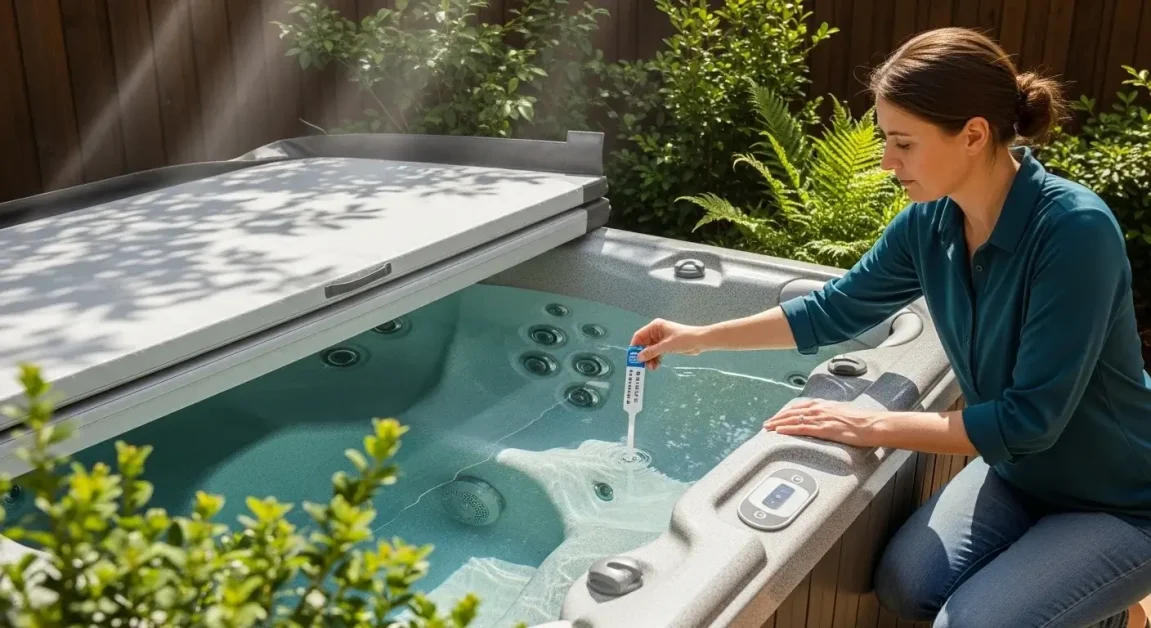
1. Confirm Bromine Level
- Test the Water: Use test strips or a liquid test kit. Ideal bromine levels are 3-5 ppm. Levels above 5 ppm require action.
2. Stop Adding Bromine
- Remove Bromine Sources: Turn off automatic feeders or remove bromine tablets from floaters/dispensers.
- Avoid Shocking: Do not shock the tub, as this can convert bromide to bromine, exacerbating the issue.
3. Lower Bromine Levels
- Neutralize with Sodium Thiosulfate:
- Use a bromine neutralizer (sodium thiosulfate) following product instructions. Dose carefully to avoid over-reduction.
- Note: This may lower pH; rebalance after use.
- Hydrogen Peroxide (Alternative):
- Use 35% hydrogen peroxide (pool-grade). Add gradually (typically 1 oz per 100 gallons) and retest. Monitor pH as it may drop.
4. Dilute the Water
- Partial Drain & Refill:
- Drain 1/3 to 1/2 of the water (e.g., for 10 ppm → 5 ppm, replace 50%).
- Refill with fresh water and recheck bromine. Adjust other chemicals (pH, alkalinity) as needed.
5. Aerate the Water
- Run Jets: Increase aeration by running jets uncovered to help dissipate bromine. Note: Bromine dissipates slower than chlorine.
6. Retest and Rebalance
- Test Again: Ensure bromine is 3-5 ppm. Adjust if necessary.
- Balance Chemistry: Check and adjust pH (7.2-7.8), alkalinity (80-120 ppm), and sanitizer levels.
7. Prevent Future Issues
- Adjust Feeders: Reduce bromine tablet quantity or feeder settings.
- Regular Testing: Test water 2-3 times weekly.
- Mindful Shocking: Use non-chlorine shock (MPS) if needed, and avoid over-shocking.
Safety Tips:
- Avoid Use: Do not enter the tub until bromine is ≤5 ppm.
- Disposal: Follow local guidelines for draining chemically treated water.
Understanding Bromine in Hot Tubs
What Is Bromine and How Does It Work?
A powerful sanitizer for hot tubs plays a crucial role in keeping your water clean and safe. Similar to chlorine, it works by eliminating bacteria, viruses, and other harmful contaminants. However, bromine, preferred by many hot tub owners for its distinct advantages, offers unique benefits. A game changer for those seeking effective water sanitation.
Overview of Bromine as a Sanitizer
Unlike chlorine, which breaks down quickly in warm water, bromine stays active longer, providing continuous sanitation. This means you don’t need to add it as often, and your hot tub stays cleaner with less effort. Bromine is also gentler on the skin and eyes, which can make your soaking experience more enjoyable.
Comparison: Bromine vs. Chlorine for Hot Tubs
| Feature | Bromine | Chlorine |
|---|---|---|
| Longevity | Remains active longer, requiring less frequent dosing | Dissipates quickly, needing more frequent additions |
| Stability in Hot Water | More stable in hot water, less affected by temperature | Breaks down faster in hot water |
| Skin and Eye Irritation | Gentler on skin and eyes | Can cause irritation, especially at higher levels |
| Odor | Milder odor, less chemical smell | Stronger, more noticeable chlorine smell |
| Effectiveness | Slower acting but provides continuous sanitation | Fast-acting, but needs more frequent application |
Benefits of Using Bromine Tablets for Hot Tubs
A convenient option for hot tub sanitation, release the sanitizer steadily over time. Dissolving slowly, these tablets ensure consistent bromine levels with minimal maintenance, allowing you to keep the water balanced without constant attention. A breath of fresh air for those looking to enjoy a more relaxing hot tub experience.
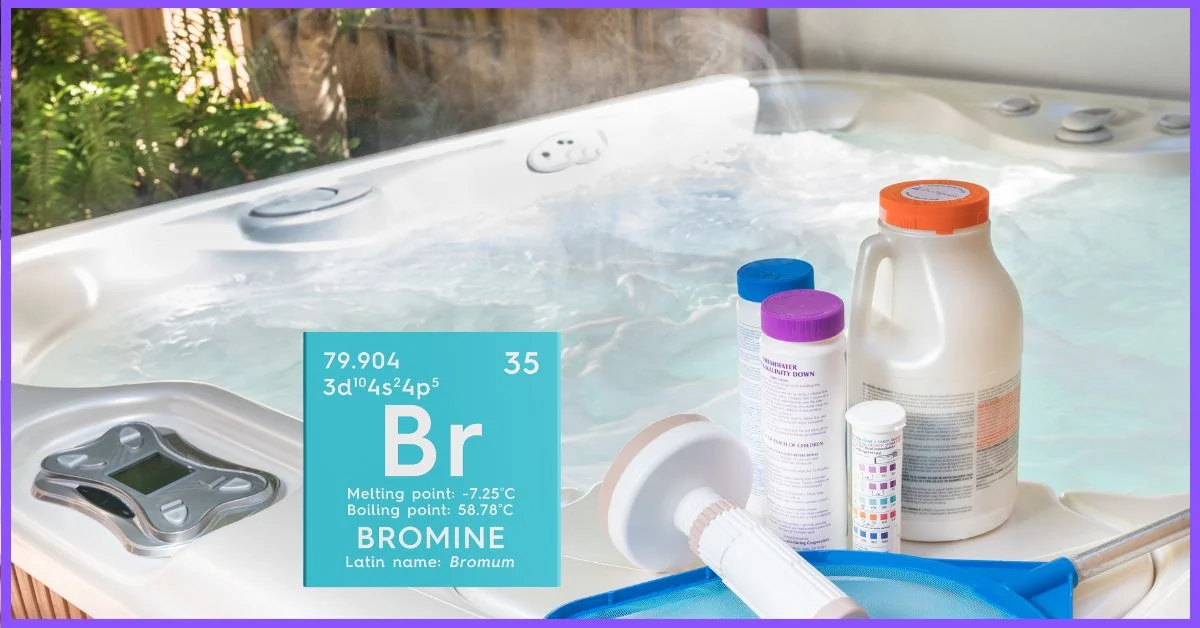
Check Our Guide About WATER CARE TROUBLESHOOTING
What Is a Safe Bromine Level in a Hot Tub?
Maintaining the proper level is crucial for ensuring both safety and comfort when using your hot tub. The ideal bromine level typically falls between 3 and 5 ppm (parts per million). Keeping it within this range helps protect against harmful bacteria while avoiding potential skin irritation.
Testing Bromine Levels:
Testing should be done at least once a week, or more frequently if the hot tub is in heavy use. This routine helps you maintain a clean, safe environment, allowing you to enjoy your hot tub without worry.
- Use Test Strips or a Liquid Test Kit
- Dip the test strip into the water or use a liquid kit designed for hot tubs.
- Wait for the strip to change color or follow the instructions on the liquid kit.
- Compare the Results
- Match the color change on the strip to the provided chart to determine the bromine level.
- If using a liquid kit, follow the instructions to measure the concentration.
- Adjust as Needed
- If the bromine level is too low, add more bromine tablets or a shock treatment.
- If the level is too high, follow steps to lower it, such as diluting the water or using a bromine neutralizer.
✨ Bromine Hot Tub Care Guide
🧪 Bromine Basics
Maintain perfect water balance with proper bromine use. Tablets provide steady sanitization, keeping your hot tub clean with minimal effort.
🔢 Tablet Dosage
- Small tub (≤200 gal): 1-2 tablets
- Medium tub (200-400 gal): 2-3 tablets
- Large tub (400+ gal): 3-4 tablets
🛟 Floater Tips
- Load with correct tablet count
- Adjust vent for dissolution rate
- Check weekly and refill
⚙️ Dispenser Setup
- Install per manufacturer instructions
- Load with recommended tablets
- Adjust release rate for your usage
💡 Always test water regularly and follow product instructions
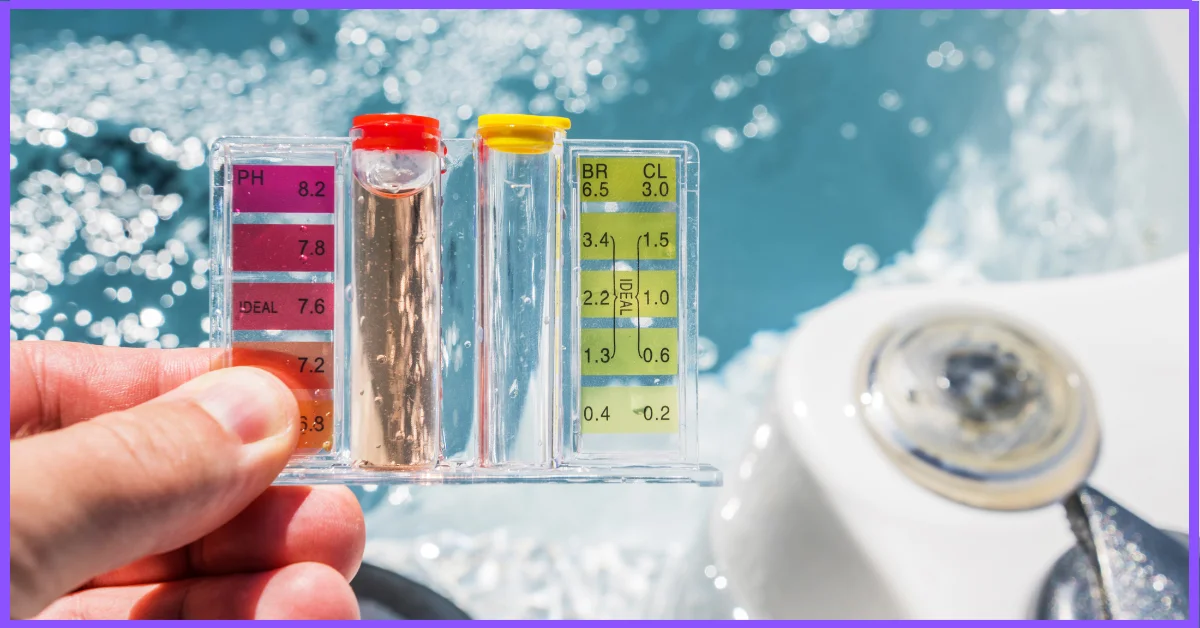
🌡️ Bromine Hot Tub Maintenance
🚀 First-Time Bromine Setup
- Shock the water to remove contaminants
- Add bromine tablets to floater/dispenser
- Test after 24 hours (ideal range: 3-5 ppm)
⚡ When to Shock Your Tub
👥 After Heavy Use
When many people have used the tub
☁️ Cloudy Water
Or if water has odd smells
⬆️ Raising Bromine
- Add more tablets
- Use shock treatment
- Run jets to distribute
⬇️ Lowering Bromine
- Remove bromine source
- Partial water change
- Use neutralizer
⚠️ Never mix bromine and chlorine directly
Stick to one sanitizer type for best results
Troubleshooting Bromine Issues
Sometimes things can go wrong, leading to high levels, skin reactions, or other issues. This section will guide you through common bromine-related problems and how to address them effectively.
Is High Bromine in a Hot Tub Dangerous?
High bromine levels (above 5 ppm) can irritate skin, eyes, and lungs, and long-term exposure may damage spa parts. At levels like 10–20 ppm, it becomes unsafe to soak, especially for kids or those with sensitive skin. Over time, it may also corrode your hot tub cover and plumbing.
Too Much Bromine in a Hot Tub Side Effects: What to Watch Out For
Excessive bromine levels can lead to several side effects, including:
- Skin Irritation and Rashes
- Prolonged exposure to high bromine levels can cause red, itchy skin and rashes.
- Eye Irritation
- The fumes from high bromine levels can cause burning or itchy eyes.
- Respiratory Issues
- Breathing in high concentrations of bromine vapors can irritate the respiratory system, leading to coughing or difficulty breathing.
If you experience any of these symptoms, it’s important to lower the bromine levels before using the hot tub again.
Bromine Rash Hot Tub: Identifying and Treating Skin Reactions
A rash is a common issue caused by high levels of bromine in your hot tub. It appears as red, itchy bumps on the skin, often resembling a heat rash. Follow to treat:
- Exit the Hot Tub Immediately
- Stop using the hot tub until the bromine levels are reduced.
- Rinse Off
- Rinse your skin with clean, lukewarm water to remove any remaining bromine.
- Apply a Soothing Lotion
- Use an over-the-counter hydrocortisone cream or a soothing lotion to reduce itching and inflammation.
- Lower Bromine Levels
- Follow the steps to lower bromine levels before using the hot tub again. Check out How to Lower Bromine in Hot Tub.
Foaming in Hot Tub Due to Bromine: Causes and Solutions
Foaming can be unsightly and is often caused by high bromine levels. Other contributing factors include:
- Body oils and lotions
- Detergent residues from swimwear
- Excessive use of chemicals
To eliminate foaming:
- Balance Your Water Chemistry
- Test and adjust the bromine levels to the recommended range.
- Use a Defoamer
- Add a defoaming agent specifically designed for hot tubs to reduce foam instantly.
- Rinse Off Before Entering
- Encourage bathers to rinse off before using the hot tub to minimize oils and lotions.
- Clean Your Hot Tub Regularly
- Regularly clean and maintain your hot tub to prevent the buildup of contaminants.
What Causes High Bromine in a Hot Tub?
Too much bromine, skipping water tests, or setting the floater too high are the usual culprits. Here’s how to avoid it:
- Measure carefully based on your hot tub size and use.
- Test weekly to catch rising levels early.
- Adjust the floater to control how much bromine is released.
Common Mistakes That Raise Bromine Levels:
- Adding more bromine than needed
- Forgetting to test the water
- Leaving the floater fully open
How to Lower Bromine Fast:
- Remove the bromine source (floater or dispenser)
- Dilute the water by draining and refilling part of the tub
- Use a neutralizer like sodium thiosulfate to bring levels down quickly
Lowering Bromine in an Inflatable Hot Tub: Specific Tips for Portable Spas
Inflatable hot tubs are smaller and may require different approaches to manage bromine levels:
- Use Fewer Tablets
- Because of their smaller size, inflatable hot tubs need fewer bromine tablets. Start with one tablet and adjust as needed.
- Test More Frequently
- The water chemistry in inflatable hot tubs can change rapidly, so it’s important to test the water every few days.
- Dilute Carefully
- If you need to lower bromine levels, remove a small amount of water and replace it gradually, checking the levels as you go.
Effects of Low Bromine in a Hot Tub
Too little bromine (under 3 ppm) can lead to:
- Cloudy water
- Bacterial growth
- Foul odors
- Skin infections (like hot tub rash)
- Poor sanitation during heavy use
Balance is key, too high is unsafe, too low is unsanitary.
Is 10 or 20 ppm Bromine Dangerous?
Yes. Here’s a quick reference:
| Bromine Level | Safety Status | Notes |
|---|---|---|
| 3–5 ppm | Safe | Ideal range for soaking |
| 6–9 ppm | Caution | May cause irritation |
| 10–19 ppm | Unsafe | Do not enter until reduced |
| 20+ ppm | Dangerous | High risk of chemical burns |
Even 10 ppm can cause red eyes, dry skin, and rashes, especially after long soaks.
Maintaining Balanced Bromine Levels
By following these guidelines, you can maintain balanced bromine levels and ensure a clean and enjoyable hot tub experience.
How to Keep Your Bromine Levels in Range
Follow these steps to keep your bromine levels in the ideal range of 3 to 5 ppm:
- Regular Testing
- Use test strips or a liquid test kit to check bromine levels at least once a week. This helps you catch any imbalances early.
- Adjusting Bromine Tablets
- Based on your test results, add or remove bromine tablets as needed. Ensure you follow the recommended dosage for your hot tub size.
- Use a Bromine Floater or Dispenser
- A floater or dispenser can help maintain consistent bromine levels. Adjust the flow rate as necessary based on your water tests.
- Maintain Proper Water Circulation
- Good water circulation helps evenly distribute bromine throughout the hot tub. Make sure your pump and jets are functioning properly.
What Level of Bromine Is Considered Dangerous?
- Safe Range: 3–5 ppm
- Mildly High: 6–8 ppm — may cause slight discomfort
- Too High: 10+ ppm — not safe for use
- Danger Zone: 20 ppm or more — do not use your hot tub until corrected
At 20 ppm, you risk serious skin irritation, cloudy water, and strong chemical fumes. The tub should remain closed until corrected.
Preventing Low Bromine Levels in Hot Tubs: How to Avoid Common Pitfalls
Low bromine levels can lead to ineffective sanitation and potential water quality issues. Here’s how to prevent them:
- Avoid Overuse
- If your hot tub is heavily used, bromine levels can drop quickly. Increase the number of tablets or adjust the floater settings accordingly.
- Regular Shocking
- Shocking your hot tub with bromine shock treatment helps maintain effective sanitation, especially after heavy use.
- Prevent Contaminants
- Ensure bathers rinse off before entering the hot tub to reduce the introduction of oils and lotions that can consume bromine.
- Check and Maintain Equipment
- Regularly inspect and maintain your hot tub’s equipment, including the pump and filter, to ensure they’re working properly.
How to Get Bromine Levels Up in a Hot Tub:
If your bromine levels are too low, take these steps to raise them effectively:
- Add More Bromine Tablets
- Increase the number of tablets in your floater or dispenser based on the size of your hot tub and current bromine levels.
- Shock the Water
- Use a bromine shock treatment to quickly boost bromine levels. Follow the product’s instructions for the correct amount to use.
- Adjust the Floater or Dispenser Settings
- If you’re using a floater or dispenser, adjust its settings to release bromine at a higher rate.
- Run the Jets
- Turn on the hot tub’s jets to help distribute the bromine more evenly throughout the water.
Hot Tub Chemical Maintenance:
Maintaining your hot tub’s chemical balance requires consistent care. Here’s a routine to help you avoid bromine imbalances:
- Weekly Testing and Adjusting
- Test bromine levels weekly and adjust as needed to stay within the 3 to 5 ppm range.
- Regular Shocking
- Shock the water at least once a week or after heavy use to keep the bromine levels effective.
- Clean the Hot Tub
- Regularly clean your hot tub to prevent buildup of contaminants that can affect bromine levels.
- Monitor pH Levels
- Ensure the pH level of your hot tub water remains balanced, as an improper pH can affect bromine’s efficiency.
- Inspect Equipment
- Regularly check and maintain your hot tub equipment to ensure proper operation and even distribution of chemicals.
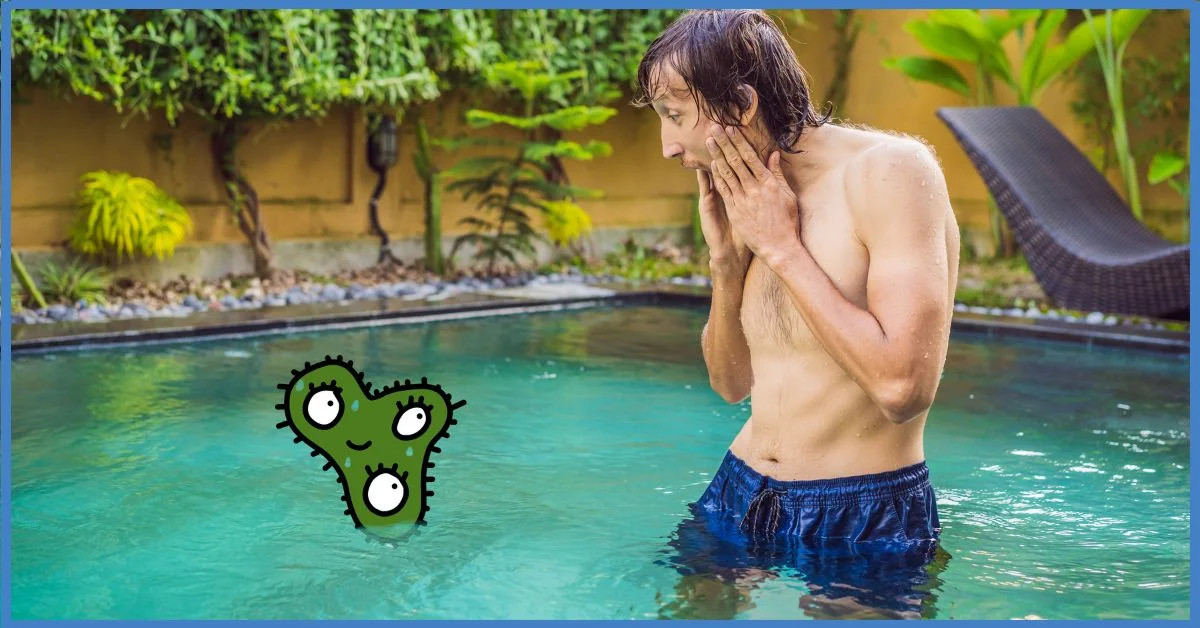
Explore the finer points of bromine maintenance, pH balance, and water quality for an exceptional soaking experience.
Featured Products and Resources
Finding the right products and resources can make a significant difference in maintaining your hot tub. Here’s a selection of recommended items and guides to help you keep your hot tub in top shape.
Hot Tub Bromine Tablets:
Choosing the right bromine tablets is crucial for effective sanitation. Here are some top options:
- Spa Choice Bromine Tablets
Reliable and long-lasting, these tablets are ideal for maintaining steady bromine levels in your hot tub. - Clorox Pool&Spa Bromine Tablets
Known for their high quality and effectiveness, these tablets provide consistent bromine levels for clean and clear water. - In The Swim Bromine Tablets
A popular choice among hot tub owners, these tablets offer excellent performance and ease of use.
Hot Tub Water Care Kits
Comprehensive water care kits help manage your hot tub’s chemistry effectively. Consider these options:
- Hot Tub Water Care Kit
Includes essential chemicals and test strips for maintaining balanced water and preventing issues. - Spa Essentials Water Care Kit
Offers a complete solution for water maintenance, including shock treatments and sanitizers.
Hot Tub Filter Cleanse Products
Keeping your filter clean ensures efficient water circulation and chemical distribution. Recommended products include:
- SpaFilter Cleaner
A powerful cleaner that removes oils, lotions, and other contaminants from your hot tub filter. - Filter Flosser
A high-pressure cleaning tool that makes it easy to clean your hot tub filter thoroughly.
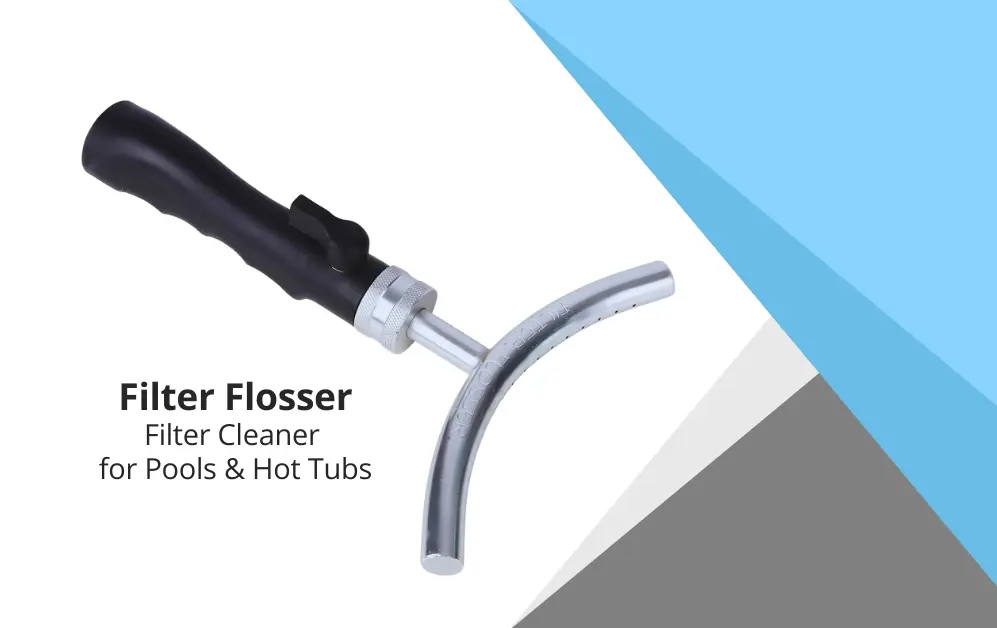
🔧 Hot Tub Maintenance Guide
Keep your hot tub in perfect condition with our expert tips and premium products. Whether you’re managing bromine levels or need general maintenance advice, we’ve got you covered!
❓ Need Help?
Have questions about bromine levels or other maintenance tips? Our experts are ready to assist you!

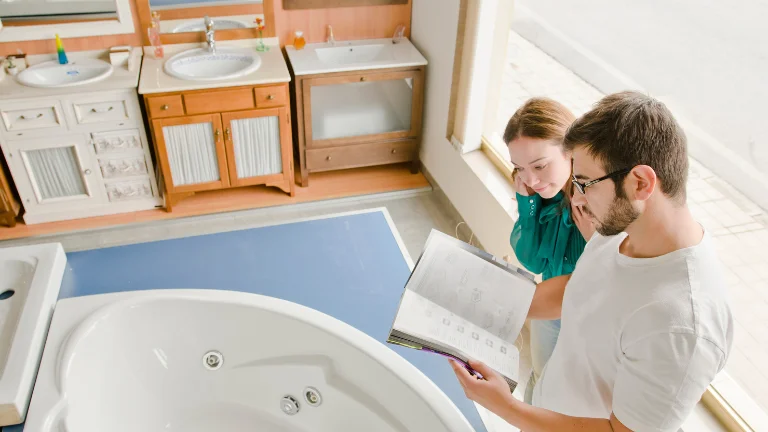





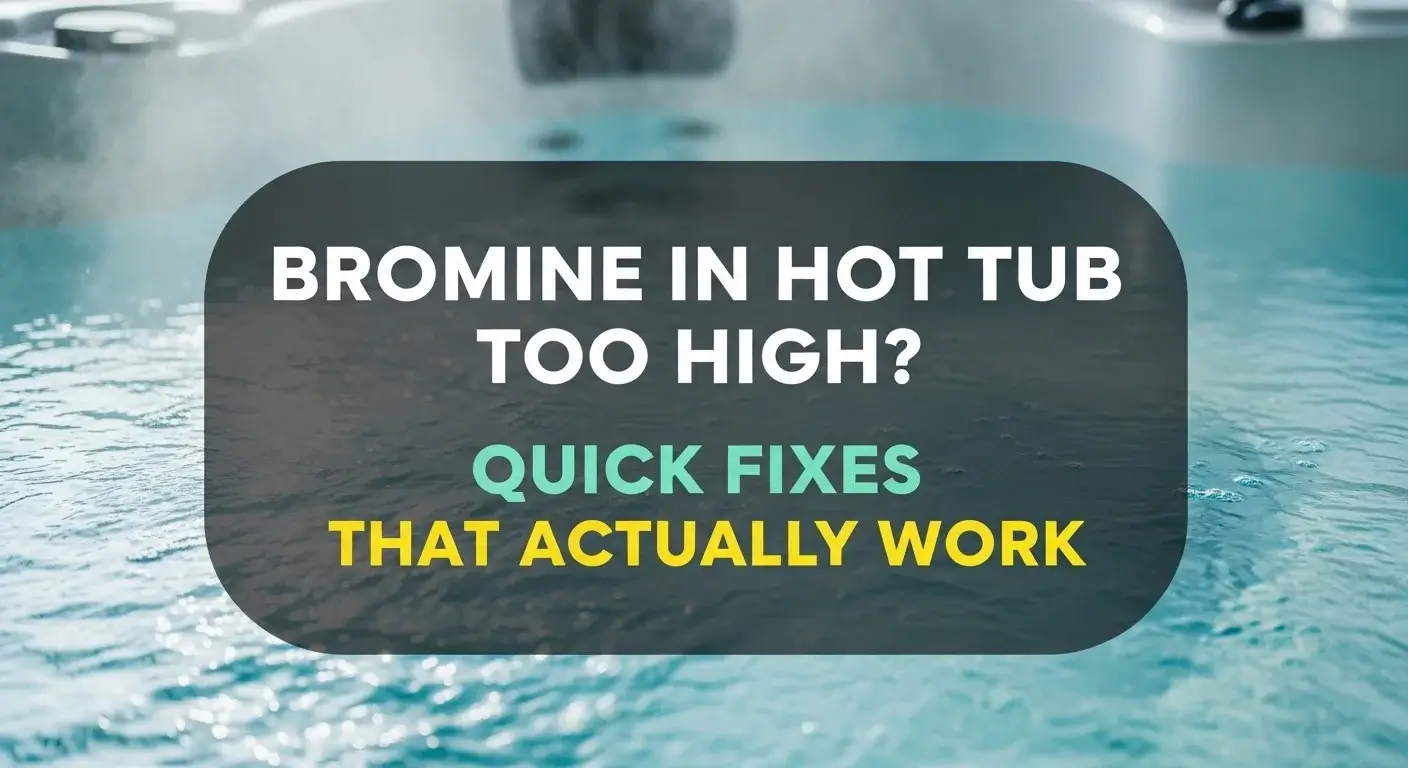
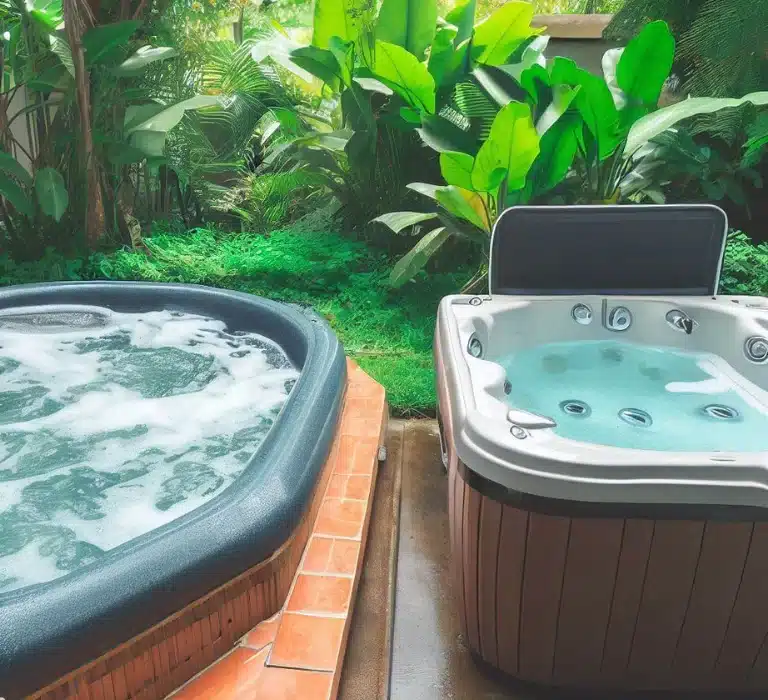


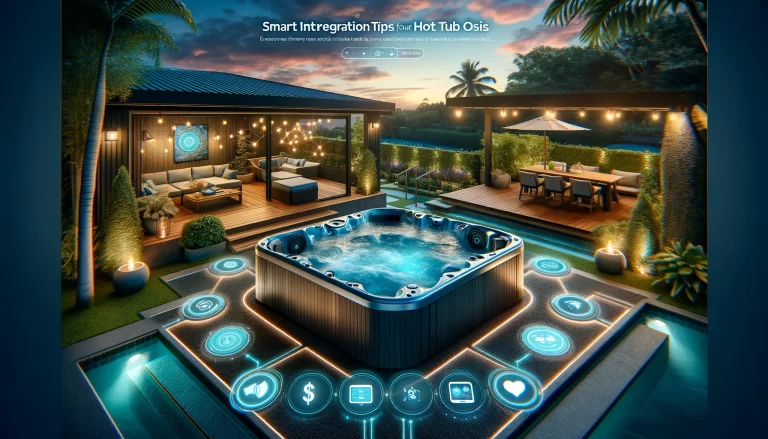


4 Comments